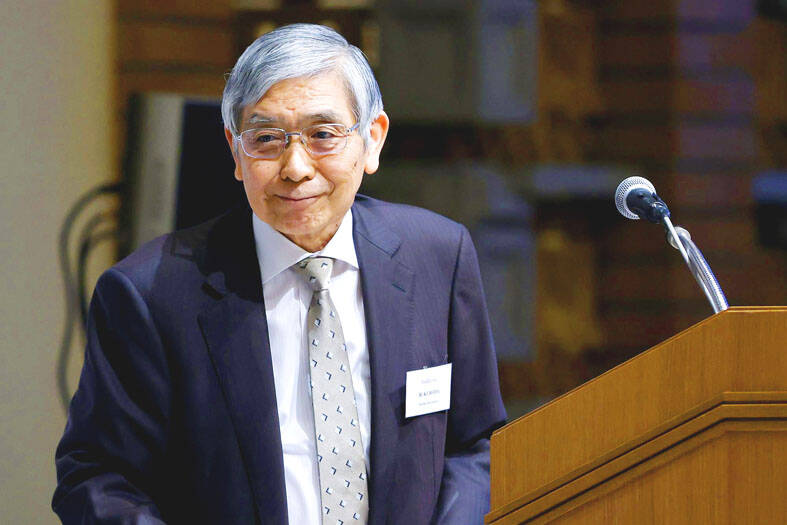Japan’s inflation last month hit its fastest clip in 40 years, an outcome that further stretches the credibility of the Bank of Japan’s (BOJ) view that continued stimulus is needed to secure stable price growth.
Consumer prices excluding fresh food climbed 3.6 percent from a year earlier, the Japanese Ministry of Internal Affairs and Communications said yesterday.
The reading outpaced a 3.5 percent forecast by analysts and marks the fastest price growth since 1982. Core inflation has now exceeded the central bank’s 2 percent price target for seven straight months, with the yen’s historic fall amplifying the trend.

Photo: Bloomberg
Following the release, BOJ Governor Haruhiko Kuroda reiterated his view that the central bank’s ultra-low interest rates remain appropriate, although he added that the latest gains were significant and inflation could accelerate further.
While economists largely agree with the BOJ that inflation would cool in Japan next year, partly as a result of government subsidies, some analysts see the central bank underestimating the underlying strength of prices.
“It’s getting harder for the BOJ to keep saying that the current cost-push inflation is temporary,” Daiwa Securities Co chief market economist Mari Iwashita said. “If the yen remains weak, more companies will try to pass on costs to consumers.”

Photo: REUTERS
The BOJ remains the outlier among major central banks. While its peers have long since given up the view that hot prices are merely transitory, and have aggressively raised borrowing costs, Kuroda has stuck resolutely with rock-bottom interest rates.
That stance has helped drive the yen to 32-year lows against the US dollar, prompting repeated government intervention in currency markets.
Kuroda has consistently said that the current inflation is unsustainable and driven by import costs and the weaker currency, as he looks to keep policy on hold during the final months of his leadership.
“I believe price growth will fall below 2 percent next fiscal year onward,” Kuroda yesterday told parliament.
The latest data show that price rises are continuing to spread beyond energy costs.
Gains in processed food costs now outweigh the impact of elevated power and fuel prices, the report showed.
Excluding fresh food and energy, price growth has reached 2.5 percent, an indication that the strength of the inflation trend is firmly beyond 2 percent.
Last month, companies raised the prices of about 6,700 food items, ranging from mayonnaise to beverages, a Teikoku Databank survey showed.
Although the trend appears to have peaked last month, the prices of another 833 food items, including dairy products, are expected to increase this month.
To ease the hit of higher prices on consumption, Japanese Prime Minister Fumio Kishida last month ordered an economic stimulus package that includes aid to reduce energy costs and cash handouts for childcare.
His Cabinet has approved an extra budget of ¥29.1 trillion (US$207.7 billion) to partly fund these measures.
Bloomberg economist Yuki Masujima said that the government “is putting no pressure on the BOJ to pivot. It prefers to keep interest rates ultra-low to finance its debt, including the new borrowing required by its latest stimulus package.”
Kuroda, whose term finishes in April next year, has singled out wage growth as the key factor needed to create an environment of lasting growth in prices and the economy.

MULTIFACETED: A task force has analyzed possible scenarios and created responses to assist domestic industries in dealing with US tariffs, the economics minister said The Executive Yuan is tomorrow to announce countermeasures to US President Donald Trump’s planned reciprocal tariffs, although the details of the plan would not be made public until Monday next week, Minister of Economic Affairs J.W. Kuo (郭智輝) said yesterday. The Cabinet established an economic and trade task force in November last year to deal with US trade and tariff related issues, Kuo told reporters outside the legislature in Taipei. The task force has been analyzing and evaluating all kinds of scenarios to identify suitable responses and determine how best to assist domestic industries in managing the effects of Trump’s tariffs, he

TIGHT-LIPPED: UMC said it had no merger plans at the moment, after Nikkei Asia reported that the firm and GlobalFoundries were considering restarting merger talks United Microelectronics Corp (UMC, 聯電), the world’s No. 4 contract chipmaker, yesterday launched a new US$5 billion 12-inch chip factory in Singapore as part of its latest effort to diversify its manufacturing footprint amid growing geopolitical risks. The new factory, adjacent to UMC’s existing Singapore fab in the Pasir Res Wafer Fab Park, is scheduled to enter volume production next year, utilizing mature 22-nanometer and 28-nanometer process technologies, UMC said in a statement. The company plans to invest US$5 billion during the first phase of the new fab, which would have an installed capacity of 30,000 12-inch wafers per month, it said. The

In a small town in Paraguay, a showdown is brewing between traditional producers of yerba mate, a bitter herbal tea popular across South America, and miners of a shinier treasure: gold. A rush for the precious metal is pitting mate growers and indigenous groups against the expanding operations of small-scale miners who, until recently, were their neighbors, not nemeses. “They [the miners] have destroyed everything... The canals, springs, swamps,” said Vidal Britez, president of the Yerba Mate Producers’ Association of the town of Paso Yobai, about 210km east of capital Asuncion. “You can see the pollution from the dead fish.

Taiwan’s official purchasing managers’ index (PMI) last month rose 0.2 percentage points to 54.2, in a second consecutive month of expansion, thanks to front-loading demand intended to avoid potential US tariff hikes, the Chung-Hua Institution for Economic Research (CIER, 中華經濟研究院) said yesterday. While short-term demand appeared robust, uncertainties rose due to US President Donald Trump’s unpredictable trade policy, CIER president Lien Hsien-ming (連賢明) told a news conference in Taipei. Taiwan’s economy this year would be characterized by high-level fluctuations and the volatility would be wilder than most expect, Lien said Demand for electronics, particularly semiconductors, continues to benefit from US technology giants’ effort